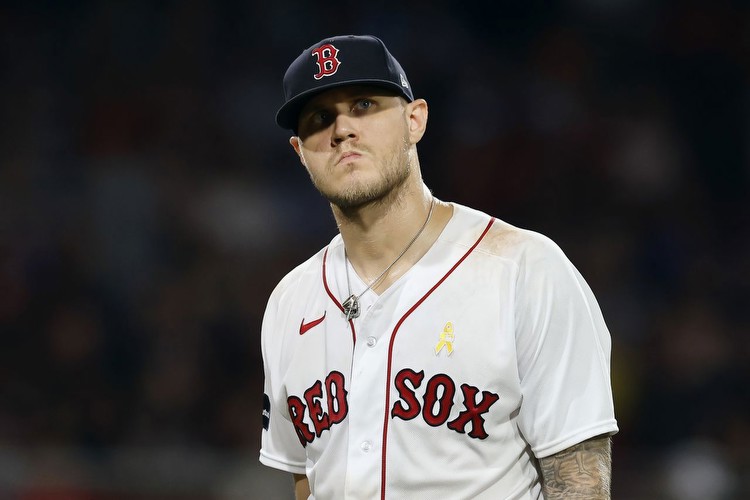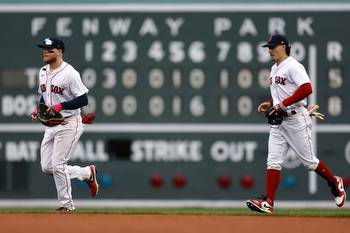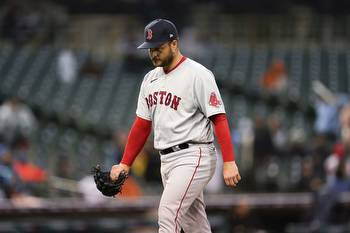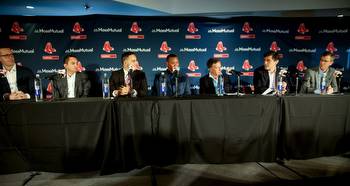Red Sox rotation was a bust in 2023, in both quality and quantity

The Red Sox entered 2023 with a deep rotation group that carried plenty of upside... and plenty of risk. By the end, much of the team’s shortcomings were due to the risk aspect manifesting itself — and only a select number of its starters exceeding expectations.
After a 2022 campaign in which the Red Sox felt they were consistently short on rotation depth, former chief baseball officer Chaim Bloom entered last offseason with a clear goal of getting deeper. The Sox entered spring training with seven big league rotation candidates (Corey Kluber, Chris Sale, Nick Pivetta, Garrett Whitlock, Brayan Bello, James Paxton and Tanner Houck), two swingman depth options (Kutter Crawford and Josh Winckowski) and three prospects who were expected to debut during the season (Bryan Mata, Chris Murphy and Brandon Walter). Bloom and manager Alex Cora reasonably believed they had a group that was 12 pitchers deep. It didn’t take long for injuries to take over.
MA only. 21+. Gambling Problem? If you or a loved one is experiencing problems with gambling, please call 1-800-327-5050 or visit gamblinghelplinema.org for 24/7 support. LiveChat with a GameSense Advisor at GameSenseMA.com or call 1-800-GAM-1234MA Gambling Helpline.Bello and Paxton both got hurt during camp and Whitlock’s rehab stalled, meaning Cora’s “seven starters for five spots” problem quickly turned into a fire drill. Crawford was inserted into the big league rotation and Winckowski, who was likely slated for Triple-A, made the team as a reliever. Both of those pitchers, along with Bello and the second-half version of Pivetta, took big steps forward. Almost everyone else took a step back.
The rotation woes started on Opening Day with Kluber, who will go down as one of the worst moves of Bloom’s tenure in Boston. Signed to bring certainty and stability to a group that lacked it, Kluber had a season that was an abject failure in every way. In total, he was paid $10 million to post a 7.04 ERA in just 55 innings before a shoulder injury ended his season in mid-June. Some in the organization had questions about his shoulder at the time Bloom signed him in December and believe he was never fully healthy to begin with. Regardless, banking on a 37-year-old with plenty of recent health issues was a big gamble and it didn’t work out.
Sale, too, had a bit of a disappointing season despite still flashing his ceiling in stretches. The eye test was kinder than the numbers, considering that Sale’s stuff looked vintage at times and he had some tremendous outings, especially in May and September. But the line doesn’t lie. The Red Sox, perhaps naively, were banking on more than six wins, a 4.30 ERA and 102 ⅔ innings out of their one-time ace.
From a pitching perspective, perhaps the biggest disappointments of the Sox’ season were Houck and Whitlock, who were finally given chances to be full-time starters and flopped. Whitlock spent three different stints on the injured list and posted a 5.15 ERA (albeit with a more encouraging 4.27 FIP) in just 71 ⅔ innings, giving Boston just 10 starts in the process. Houck, whose season was cut in half when he was hit with a comebacker in June, did make 21 starts but was not very effective in many. He had just five quality starts, the Red Sox were 9-12 when he pitched and he finished with a 5.01 ERA. He continued to struggle to pitch deep into games, getting through more than five innings just eight times.
The reinforcements from Triple-A, at least in the rotation, never came. Mata was expected to contribute but was hurt for most of the year and now enters the winter in roster limbo. Murphy and Walter entered the year as top rotation prospects but now profile more as relievers after up-and-down cups of coffee in the majors. Even Shane Drohan, who emerged as the organization’s best pitching prospect, had some shine come off with a brutal first showing at Triple-A. He was not in consideration for a spot start even when injuries forced the Red Sox to use openers in 40% of their games throughout July.
Entering the year, it was easy to envision pretty much everyone in the rotation mix reaching their ceilings. Instead, many hit their floors. Even the seasons of those who pitched well come with black marks. Paxton dominated during the summer (2.73 first-half ERA) but had a brutal second half (6.98 ERA) and broke down physically. Bello hit a wall (5.49 second-half ERA). Crawford pitched into the sixth inning just nine times in 23 starts. The mercurial Pivetta even needed to be kicked out of the rotation to reach his ceiling.
All of those factors amounted to a disappointing season for a rotation group that does not lack talent. The Red Sox finished 22nd in rotation ERA (4.68), one spot ahead of the 100-loss White Sox. And perhaps most tellingly, Boston got just 774 ⅓ innings out of its rotation, which was good for the fourth-lowest total in baseball. Many contenders hovered around the 900-inning mark. Simply put, the oft-injured group didn’t deliver quality or quantity.
“To win championships, you have to pitch,” said manager Alex Cora. “That’s the bottom line. And we haven’t been able to get to that point yet, right? I think the last time we have had a healthy rotation was in ‘21. You saw what happened. Before that... the other time we were healthy, it was ‘18. So that’s something that the group knows.
“Maybe we have to make adjustments as far as the things that we do with them, preparing them, their offseason workouts, all of that. But as of now, you see the talent, obviously. This is something that whoever is going to run the organization is going to decide which route are we going to go. But yeah, we have to pitch better. That’s important.”
The Red Sox enter the winter with you guessed it, more questions than answers when it comes to the rotation. Bello will have a spot. Sale will, too, though he’s not to be counted on for a high innings total as he enters his age-35 season. Crawford should be penciled in, though there’s a chance he could be moved to the bullpen... or another team as a high-value trade piece. Pivetta, Houck and Whitlock are all under control but have nebulous roles. Kluber is a goner and most likely so is Paxton, who doesn’t seem likely to return in free agency.
Also concerning for the Red Sox is the fact that the pitching pipeline at the highest level of the minors has run dry. With the top six prospects in the organization (per SoxProspects) all position players and the two top arms in the system (Luis Perales and Wilkelman Gonzalez) yet to reach Triple-A, there’s no top-level reinforcement coming early in 2024. Drohan, Walter and Mata no longer look like top-line starters. Even after signs of life from Bello, Crawford, and in the past, Houck, there’s still an organization-wide issue when it comes to developing homegrown starting pitching. Reinforcements will have to come from the outside.
It’s no secret that Bloom’s replacement will be on the lookout for quality rotation pieces this winter, both on the free agent market and in trade. The bones of a strong starting five are in place with Bello, Sale (if healthy), Crawford and Pivetta. But it’s a safe bet to believe the Sox’ best starter in 2024 (or maybe their best two) is not on the roster yet. Yoshinobu Yamamoto, Blake Snell and Aaron Nola are great fits for the top of the rotation with Lucas Giolito, Jordan Montgomery and Sonny Gray as some other potential free agent options.
The Red Sox know their rotation needs to be better if they want to contend.
“The whole organization is looking forward,” said team president Sam Kennedy. “And I think there’s lots of areas for improvement. Obviously, this game is about pitching at the end of the day. So we need to improve in that area. That certainly does come to mind. That’s a fair criticism to point out. But we’ll attack it all in the offseason.”




































